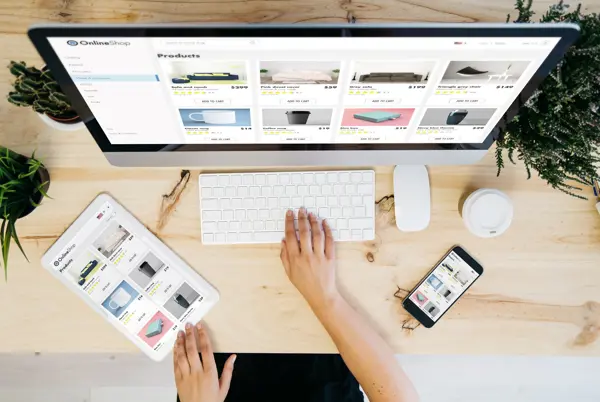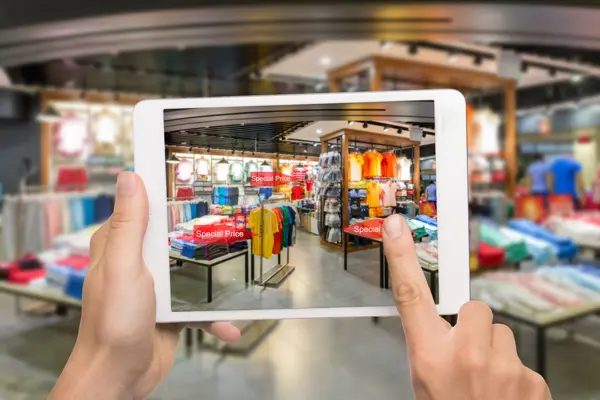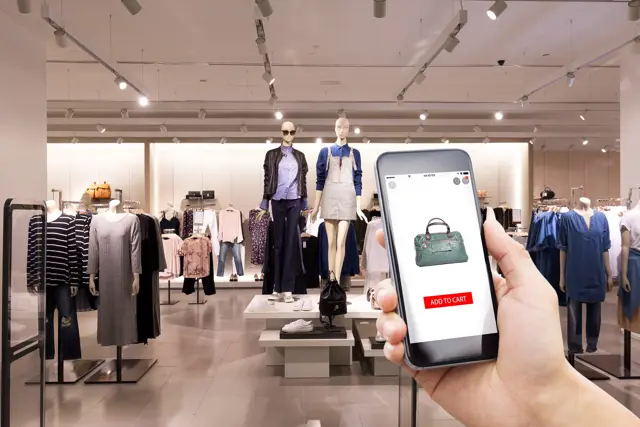Get more Retail Sector insight from HSO
Dynamics Matters Podcast: Ep 12 - What digital transformation means, and the advantages it offers
With special guest CTO Shaun Perkinson, one of HSO’s retail customers Boden.
✔ What was not working for Boden?
✔ Why Boden selected Dynamics 365?
✔ Why Boden selected HSO as a Partner?

What digital transformation means, and the advantages it offers
Today I’m pleased to be joined by CTO Shaun Perkinson, one of HSO’s retail customers Boden. As we’re in the middle of a digital transformation programme, I thought it a good idea to pick his brains about why you might begin such a project, what the value is they’re looking for and what advice Shaun might have for any other organisation considering their own digital journey, and here he doesn’t disappoint.
Transcript
Michael Lonnon – 00:02
Today I’m pleased to be joined by CTO Shaun Perkinson, one of HSO’s retail customers Boden. As we’re in the middle of a digital transformation programme, I thought it a good idea to pick his brains about why you might begin such a project, what the value is they’re looking for and what advice Shaun might have for any other organisation considering their own digital journey, and here he doesn’t disappoint.
Michael Lonnon – 01:30
Digital transformation, jargon or legitimate?
Shaun Perkinson – 01:40
Bit of both I think.
Michael Lonnon – 01:42
What does it mean for you and Boden?
Shaun Perkinson – 00:47
Well when I say a bit of both, I try and answer that question just through the lens of the sector we’re in which is fashion retail. I just think it’s getting harder and harder to answer that question succinctly, because it is all encompassing.
Michael Lonnon – 02:09
It’s not one thing is it, it’s a mix of everything?
Shaun Perkinson – 02:13
Well, it is, completely. And, I think also we talk about data in equal measures. I don’t think I have any conversation where we talk about digital capability where we’re not also talking about data and being data driven.
Improving Online Operations For The Retail Store
E-Commerce retailing has grown rapidly in recent years. It surged ahead in the Covid pandemic and then slipped backwards when the pandemic ended. Even so, online volume is significantly higher than it was before the pandemic. The largest part of the gains made during Covid were kept. One benefit of the pandemic was to accelerate the omni-channel aspects of retailing.

Michael Lonnon – 02:33
Is it more … it’s probably more prevalent to say data transformation then as opposed to digital transformation?
Shaun Perkinson – 02:40
Yes a little bit, I just think the two things go hand in hand. And one doesn’t go without the other. But also, I think if we just rewind a little bit, when I say it’s all encompassing, I think in our space, digital transformation has always been associated with having an e-commerce presence, or omni channel capabilities, like, buy online pick up in store, or a client telling capability in store or social media capability. I think it’s, it’s not just the customer facing elements of the business that we think about. So when I say all encompassing, we’re very much thinking about the operational side of the business. And giving the business the right tools to do their job, automating manual processes. And again, with those right tools, making sure we’re the business the data to make better decisions
Michael Lonnon – 03:45
From Boden’s perspective, how are you digitally transforming and trying to improve how you are approach it?
Shaun Perkinson – 03:52
We’re doing a couple of fairly big initiatives at the moment. One really key approach that we’re taking is we’re building out a micro-services strategy. Within that micro-services strategy, managing the flow of data from our systems of record up into our customer or customer facing channels, and also the data flowing back into our system of record. We’re leveraging an event driven architecture. And that event driven architecture now is just shining a completely different light now on data moving through our operational systems. And this throws up all sorts of sort of digital marketing and operational use cases that we weren’t really thinking about back in the day when we were batching up orders from an e-commerce platform and shifting them to the warehouse management system for the orders to be shipped, or batching up part and price updates from the ERP and sending them to the e-com platform. Now, through an event driven architecture, this this data can be consumed and used for a multitude of use cases. So, for us, yeah, I think for us, when we think about digital transformation, data is a very, very important part of it.
6 Areas Where HSO Smart Retail Will Increase Customer Loyalty by a Minimum of 10%
In this article, we’ll talk about technology trends we’re seeing in the retail industry and why implementing some of these strategies will result in a minimum 10% increase in customer loyalty. After all, we know that on average, it costs 5 times more to acquire new customers than to retain existing customers and that a simple 5% increase in customer retention can increase profits by 25% to 95%.

Michael Lonnon – 05:30
How did you approach it? Did you have an objective in mind that you wanted to get to? Or did you realise, well, we are behind, we need to get, we need to change the systems in order to get ahead. What was your mindset when you approached … I say project loosely, because it never was just one project, it is multiple things coming together.
Shaun Perkinson – 05:53
No, it’s not. I think it’s your overall vision and the overall strategy to execute that vision. So I think the easiest way I think I can explain it is actually how my team and I, how we talk about it to our board, how we talk about it to my colleagues in the executive, how we talk about it across the business. It’s a really simple concept, something Gartner coined a few years ago now called a pace layered architecture. And within your pace layered architecture, I’m sure I’m telling your audience to suck eggs, but it’s about describing your application stack in three different layers.
We’re really able to look at the capability within the business and where it sits within one of these layers, and what capability we’re providing the business and then really, from a transformation lens, look at where we’ve got gaps. And some of those gaps are in the customer experience space. So there’s clear areas where we need to invest, but equally, and sometimes forgotten, I think a little bit, it also gives us a lens to look at the way in which our business is operating. And are we operating efficiently and where we’re not operating efficiently, what capability do those business teams use and allows us to start to tell that story around that digital capability we want to bring into each area? So given that a system of record, which is a system of record, investment is something that we’re focused on at the moment. I mean, that is quite a long, it’s quite a big commitment.
Michael Lonnon – 07:47
How long out of interest?
Shaun Perkinson – 07:52
Yeah, I mean, we’ve got a strategy that’s going to run for the next two years and a half years. And so with that, we’re also thinking about how do we balance that with these, this is the operational side of the business, this is where data is going to play a key role in helping the business make much better margin driving decisions. But at the same time, we know we have to balance that with the transformation and the customer experience that digital customer experience is not standing still, the bar has been raised regularly by every retailer out there. So we’ve got to balance that investment between that customer experience, and the transformation and that space, as well as the business operations as well.
Michael Lonnon – 08:40
Can I ask, is the customer centre of your thinking when you’re looking at transforming digitally, when you’re looking at the different things you’re trying to fix and improve? Is it the customer … you’re trying to improve the customers experience and the customer engagement and value to customer is that what’s at the heart of this?
Shaun Perkinson – 09:00
Yes, absolutely. It’s easy to put the customer at the centre and focus all of the investment on the things that touch the customer but I think you’ve also got to look at the look at the operational areas of the business that if we run the do these things really well, they are they are going to have a knock on effect into you, into the customer experience space to allow us to scale and grow in the areas so again, I think it’s all it’s got to be that balance between everything around the customer and every touchpoint the customer has with our brand and as well as how do we just run our business a lot more efficiently and make better decisions because of the technology and the digital capability to help us is there.

Is your retail business data rich but analysis poor?
In 10 minutes, this whitepaper shows you how to have only one version of the truth (data) and make the right decisions for your retail business.

Michael Lonnon – 09:57
And when you’re talking about two year project that we … because of the length of time you’re thinking about this, there is no one size fits all is there, you’re approaching this in different ways. And it’s evolving, I guess how you’re approaching things as you move through that two year cycle, I guess it never sits still, does it?
Shaun Perkinson – 10:14
No, no, that’s true. No, I don’t think there is a one size fits all, I mean, everybody, every business is different. And every business is trying to solve different problems. But I think there are consistencies between us, so if I was to think of just us again, and our sector, when we look at our like that system, that system of record later that I mentioned, there are processes in there, where we recognise that we’re no different to any other retailer, we all need to manage a P&L, we all need to get stock from a warehouse, to a store or from a warehouse to a customer.
So there are things that we’ve got to be be good at. So bringing in the capability to just be good at this stuff, we can automate it, these processes can be standard on the systems that we’re bringing in, which means that they are a lot more repeatable, we can scale them as the business grows, or if we move into new markets, but then knowing how we want to differentiate ourselves, and where we want to be better, there are areas where we may take a different approach and bring in a different type of system sitting in there, again, that is critical to us, that micro service architecture, which is the glue between the system of record and the systems of differentiation. It’s not, say, future proofing because I think it’s more about being future ready, knowing that we can bring in systems and plug them into the environment, and in a clean and quick way.
Michael Lonnon – 12:11
They won’t cause you a lot of hassle.
Shaun Perkinson – 12:14
Yeah. But it helps us helps us solve the problems that we may need, we want to focus this on.
Why you should never postpone your CRM project
Postponing your CRM project is a very bad strategic decision… In this blog I will explain why.
In times of economic uncertainty, many companies review and re-prioritise major investments, especially in IT. Although this is understandable, it also comes with risks, yet, quite often, not delivering on your major projects can create even more risk. When times get tough, it’s even more important to have insight and to carefully manage pipeline, opportunities, customer data and relations. Therefore CRM is a critical business system and every month delayed is a delay to improved sales performance and revenue growth.

Michael Lonnon – 12:25
Now, you’re partway into your journey but there are obviously some things that you’ve learned in the time and space you’ve been doing it. If there was a fellow CTO out there who was just beginning their digital transformation journey, what advice might you give them before they start, what things should they be thinking about before they get on with it?
Shaun Perkinson – 12:46
So I think, first of all, it’s probably natural to start in the customer space first, because that’s where you’re going to have your biggest impact. It’s definitely the right place to start. But again, I’d say don’t forget about your systems of record and if you’re going to start that journey, it needs to be driven by the business and not driven by technology. And so finding that partnership in the business, finding those stakeholders in the business that want to own the transformation because bringing in new systems and the system of records based means people’s jobs are going to change and means a change from management piece is critical. So you need those partners in the business. So start with finding them seeking them out and making sure that you’re delivering this programme together as one team and not and not letting it become a technology group.
Michael Lonnon – 13:46
I picked up three key things from Shaun during the podcasts. The first is that data is central to any digital transformation project, because coupled with new systems it allows you to make better decisions and then action them. The second thing is that the customer is always central to any digital project even when they’re not. And what I mean by this is that by bringing in more advanced digital platform to improve operational systems, any efficiency gains will improve the customer experience such as faster transaction times.
Now, the final thing is that Shaun advises that digital transformation needs to be driven by the business and not by technology. So find stakeholders in the business who could take ownership, so the project becomes delivered as one team as opposed to a technology only project.
